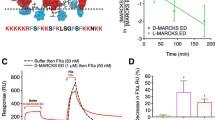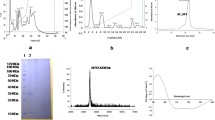Abstract
Sulfatides (galactosylceramide I3-sulfate), which are found in serum lipoproteins of various mammals, effectively increased prothrombin time (anticoagulant effect) and also effectively prolonged bleeding time (anti-platelet effect). When equal volumes of a homogeneous micellar solution of sulfatide and fibrinogen in phosphate-buffered saline were mixed, an insoluble complex precipitated. Analysis of the precipitated complex showed that the molar ratio of sulfatide to fibrinogen was about 400:1. These results indicate that the sulfatide micelle binds tightly to fibrinogen and thereby interferes with both fibrin gel formation (anticoagulant activity) and platelet function.
Similar content being viewed by others
Abbreviations
- BSA:
-
bovine serum albumin
- PBS:
-
phosphate-buffered saline
- PT:
-
prothrombin time
References
Radin NS (1983) InHandbook of Neurochemistry, Vol. 3, Metabolism in the Nervous System, 2nd edition (Lajtha A, ed.) pp. 163–77. New York: Plenum Press.
Roberts DD, Ginsburg V (1988)Arch Biochem Biophys 267: 405–15.
Fujikawa K, Heimark RL, Kurachi K, Davie EW (1980)Biochemistry 19: 1322–30.
Gailani D, Broze GJ, Jr (1993)Blood 82: 813–19.
Zhu X, Hara A, Taketomi T (1991)J Biochem 110: 241–45.
Hara A, Taketomi T (1987)J Biochem 102: 83–92.
Hara A, Taketomi T (1991)J Biochem 109: 904–8.
Wago K (1961)Jpn Heart J 2: 354–67.
Hara A, Kutsukake Y, Uemura K, Taketomi T (1993)J Biochem 113: 781–85.
Hara A, Radin NS (1979)Analyt Biochem 100: 364–70.
Quick AJ, Stanley-Brown M, Baneroft FW (1935)Am J Med Sci 190: 501–11.
Beviglia L, Poggi A, Rossi C, McLane MA, Calabrese R, Scanziani E, Cook JJ, Niewiarowski S (1993)Thromb Res 71: 301–15.
Dejana E, Villa S, de Gaetano G (1982)Thromb Haemost 48: 108–11.
Nishino T, Aizu Y, Nagumo T (1991)Thromb Res 62: 765–73.
Anderson L-O, Hoffman J, Holmer E, Larm O, Larsson K, Soderstrom G (1982)Thromb Res 28: 741–47.
Vera JC (1988)Analyt Biochem 174: 187–96.
Hara A, Radin NS (1978)Analyt Biochem 90: 420–26.
Roe JH (1955)J Biol Chem 212: 335–43.
Davies MJ, Woolf N (1993)Br Heart J 69: Suppl. S3–11.
Davies M (1990)Circulation 82: 1138–46.
Ruggeri ZM (1994)Sem Hematol 31: 229–39.
Binnie CG, Lord ST (1993)Blood 81: 3186–92.
Walzl B, Walzl M, Lechner H (1994)J Neurol Sci 126: 25–9.
Smith EB, Thompson WD, Crosbie L, Stirk CM (1992)Eur J Epidemiol 8: Suppl. 1, 83–87.
Ernst E (1993)Atherosclerosis 100: 1–12.
Tanaka K, Sueishi K (1993)Lab Invest 69: 5–18.
Hojima Y, Cochrane CG, Wiggins RC, Austen KF, Stevens RL (1984)Blood 63: 1453–59.
Mitropoulos KA, Esnouf MP (1991)Thromb Haemostas 66: 446–52.
Pixley RA, Cassello A, De La Cadena RA, Kaufman N, Coleman RW (1991)Thromb Haemostas 66: 540–47.
Wun T-C (1992)Blood 79: 430–38.
Man KG, Jenny RJ, Krishnaswamy S (1988)Ann Rev Biochem 57: 915–56.
Author information
Authors and Affiliations
Additional information
Dedicated to Dr Sen-itiroh Hakomori in celebration of his 65th birthday.
Rights and permissions
About this article
Cite this article
Hara, A., Uemura, KI. & Taketomi, T. Sulfatide prolongs blood-coagulation time and bleeding time by forming a complex with fibrinogen. Glycoconjugate J 13, 187–194 (1996). https://doi.org/10.1007/BF00731493
Received:
Revised:
Issue Date:
DOI: https://doi.org/10.1007/BF00731493




